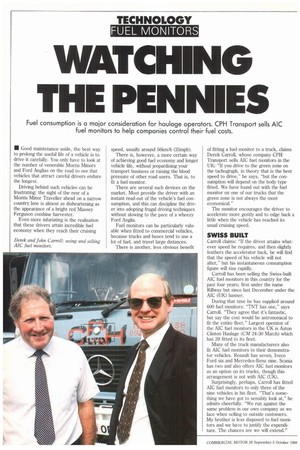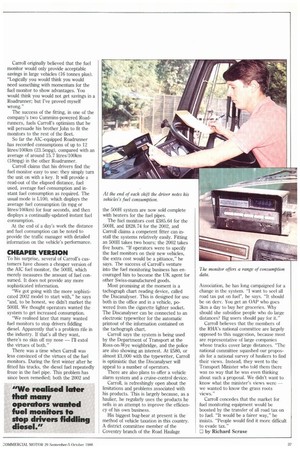WATCHING THE PENNIES
Page 30

Page 31

If you've noticed an error in this article please click here to report it so we can fix it.
Fuel consumption is a major consideration for haulage operators. CPH Transport sells AIC fuel monitors to help companies control their fuel costs.
• Good maintenance aside, the best way to prolong the useful life of a vehicle is to drive it carefully. You only have to look at the number of venerable Morris Minors and Ford Anglias on the road to see that vehicles that attract careful drivers endure the longest.
Driving behind such vehicles can be frustrating: the sight of the rear of a Morris Minor Traveller ahead on a narrow country lane is almost as disheartening as the appearance of a bright red Massey Ferguson combine harvester.
Even more infuriating is the realisation that these drivers attain incredible fuel economy when they reach their cruising Derek and John Carroll: using and selling AIC fuel monitors. speed, usually around 561unth (35mph).
There is, however, a more certain way of achieving good fuel economy and longer vehicle life, without jeopardising your transport business or raising the blood pressure of other road users. That is, to fit a fuel monitor.
There are several such devices on the market. Most provide the driver with an instant read-out of the vehicle's fuel consumption, and this can discipline the driver into adopting frugal driving techniques without slowing to the pace of a wheezy Ford Anglia.
Fuel monitors can be particularly valuable when fitted to commercial vehicles. because trucks and buses tend to use a lot of fuel, and travel large distances.
There is another, less obvious benefit of fitting a fuel monitor to a truck, claims Derek Carroll, whose company CPH Transport sells AIC fuel monitors in the UK: "If you drive to the green zone on the tachograph, in theory that is the best speed to drive," he says, "but the consumption will depend on the body type fitted. We have found out with the fuel monitor on one of our trucks that the green zone is not always the most economical."
The monitor encourages the driver to accelerate more gently and to edge back a little when the vehicle has reached its usual cruising speed.
SWISS BUILT
Carroll claims: "If the driver attains whatever speed he requires, and then slightly feathers the accelerator back, he will find that the speed of his vehicle will not alter," but his instantaneous consumption figure will rise rapidly.
Carroll has been selling the Swiss-built AIC fuel monitors in this country for the past four years; first under the name Rillway but since last December under the AIC (UK) banner.
During that time he has supplied around 600 fuel monitors: "TNT has one," says Carroll. "They agree that it's fantastic, but say the cost would be astronomical to fit the entire fleet." Largest operator of the AIC fuel monitors in the UK is Aston Clinton Haulage (CM 24-30 March) which has 39 fitted to its fleet.
Many of the truck manufacturers also fit AIC fuel monitors to their demonstrator vehicles. Renault has seven, lveco Ford six and Mercedes-Benz nine. Scania has two and also offers AIC fuel monitors as an option on its trucks, though this arrangement is not with AIC (UK).
Surprisingly, perhaps, Carroll has fitted AIC fuel monitors to only three of the nine vehicles in his fleet. "That's something we have got to sensibly look at," he admits cheerfully. "We run against the same problem in our own company as we face when selling to outside customers. My brother is less disposed to fuel monitors and we have to justify the expenditure. The chances are we will extend." Carroll originally believed that the fuel monitor would only provide acceptable savings in large vehicles (16 tonnes plus). "Logically you would think you would need something with momentum for the fuel monitor to show advantages. You would think you would not get savings in a Roadrunner; but I've proved myself wrong."
The success of the fitting, in one of the company's two Cummins-powered Roadrunners, fuels Carroll's optimism that he will persuade his brother John to fit the monitors to the rest of the fleet.
So far the AIC-equipped Roadrunner has recorded consumptions of up to 12 litres/100km (23.5mpg), compared with an average of around 15.7 litres/100km (18mpg) in the other Roadrunner.
Carroll claims that his drivers find the fuel monitor easy to use: they simply turn the unit on with a key. It will provide a read-out of the elapsed distance, fuel used, average fuel consumption and instant fuel consumption as required. The usual mode is L100, which displays the average fuel consumption (in mpg or litres/100Icm) for four seconds, and then displays a continually-updated instant fuel consumption.
At the end of a day's work the distance and fuel consumption can be noted to provide the traffic manager with detailed information on the vehicle's performance.
CHEAPER VERSION
To his surprise, several of Carroll's customers have chosen a cheaper version of the AIC fuel monitor, the 50011, which merely measures the amount of fuel consumed. It does not provide any more sophisticated information.
"We got going with the more sophisticated 2002 model to start with," he says "and, to be honest, we didn't market the 50011 We thought operators wanted the system to get increased consumption.
"We realised later that many wanted fuel monitors to stop drivers fiddling diesel. Apparently that's a problem rife in the industry. If that's all they want, there's no skin off my nose — I'll extol the virtues of both."
There was a time when Carroll was less convinced of the virtues of the fuel monitors. During the first winter after he fitted his trucks, the diesel fuel repeatedly froze in the fuel pipe. This problem has since been remedied; both the 2002 and the 500H system are now sold complete with heaters for the fuel pipes.
The fuel monitors cost 2385.64 for the 500H, and £828.74 for the 2002, and Carroll claims a competent fitter can install the systems relatively easily. Fitting an 50011 takes two hours; the 2002 takes five hours. "If operators were to specify the fuel monitors on their new vehicles, the extra cost would be a pittance," he says. The success of Carroll's venture into the fuel monitoring business has encouraged him to become the UK agent for other Swiss-manufactured goods.
Most promising at the moment is a tachograph chart reading device, called the Discanalyser. This is designed for use both in the office and in a vehicle, powered from the cigarette lighter socket. The Discanalyser can be connected to an electronic typewriter for the automatic printout of the information contained on the tachograph chart.
Carroll says the system is being used by the Department of Transport at the Ross-on-Wye weighbridge, and the police are also showing an interest. At £580, or almost £1,000 with the typewriter, Carroll is optimistic that the Discanalyser will appeal to a number of operators.
There are also plans to offer a vehicle alarm system and a cruise-control device.
Carroll, is refreshingly open about the limitations and problems associated with his products. This is largely because, as a haulier, he regularly uses the products he sells in an attempt to improve the efficiency of his own business.
His biggest bug-bear at present is the method of vehicle taxation in this country. A district committee member of the Coventry branch of the Road Haulage
Association, he has long campaigned for a change in the system. "I want to seel all road tax put on fuel", he says. "It should be on derv. You get an OAP who goes 3km a day to buy her groceries. Why should she subsidise people who do large distances? Big users should pay for it."
Carroll believes that the members of the RHA's national committee are largely opposed to this suggestion, because most are representative of large companies whose trucks cover large distances. "The national committee squashed our proposals for a national survey of hauliers to find their views. Instead, they went to the Transport Minister who told them there was no way that he was even thinking about such a proposal. We didn't want to know what the minister's views were — we wanted to know the grass roots views."
Carroll concedes that the market for fuel monitoring equipment would be boosted by the transfer of all road tax on to fuel. "It would be a fairer way," he insists. "People would find it more difficult to evade tax."
0 by Richard Scrase
















































